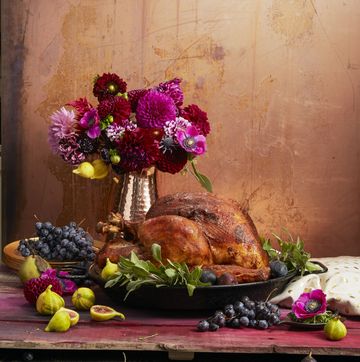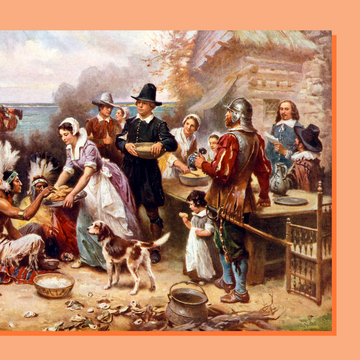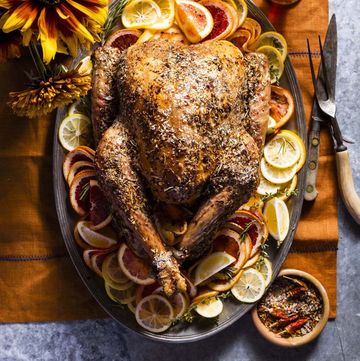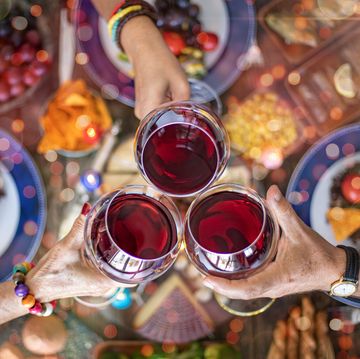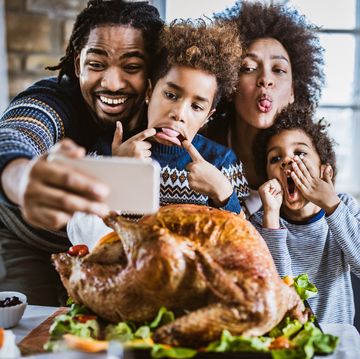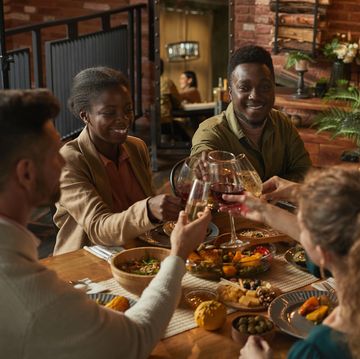During the pandemic, California health officials have often led the way by creating guidelines that inspire how other states respond to the spread of the novel coronavirus — and this Thanksgiving, new guidance on how Californians should gather at home could serve as a model for all Americans.
Ahead of the holiday season, Governor Gavin Newsom and the California Department of Public Health released guidelines designed to reduce COVID-19 risks for those who choose to invite others inside their home at Thanksgiving (as well as any other occasion, really). The guidelines encourage hosts to:
- Keep invites to fewer than 3 households (including the host's own family)
- Push for people to stay outside
- Hold gatherings for less than 2 hours
- Masks should remain on for as long as possible (barring eating and drinking)
- People should refrain from singing or shouting
- Everyone should maintain social distance if possible, even outside
Social media users are divided on the in-depth guidelines — but even California's suggestions may fail to address all risks when it comes to hosting Thanksgiving this year, according to some experts. Shruti Gohil, M.D., an epidemiologist, professor and associate medical director within the University of California Irvine's Health System, breaks down the main risks associated with hosting a Thanksgiving during the pandemic:
- Air supply and ventilation: Ideally, Thanksgiving is an al fresco-style meal this year, but if you can't head outside, take note that your risk may increase while dining indoor spaces. COVID-19 primarily spreads via droplets and aerosols from infected individuals, so ventilation and air flow play a role in how risky hosting dinner can be.
- The amount of guests: While California's three-household guest list suggestion is a start, risk can vary greatly depending on how large those families are, and transmission becomes likelier when you start adding more guests into a closed room. If guests are traveling via public transportation, risk also increases compared to if they are driving from local destinations.
- The length of the visit: Risk can increase with the amount of time one spends in close contact with someone who doesn't live in the same household. Are you simply having dinner, or will you be watching the game or the virtual Macy's parade, too? This all impacts the likelihood that you'll become sick if one of your guests is COVID-19 positive without any symptoms, or asymptomatic.
- The table set up: Buffets, shared utensils, and DIY meal stations should not be part of your plans this year. Risk can be reduced if a host carefully plans out how dinner will be served, namely trying to erase the need for people to get up and walk around during the meal (or share plates).
If you're hoping to mitigate some of the risks above, now is the time to start planning your Thanksgiving meal. With the help of infectious disease experts, we're recapping the easiest ways to work against COVID-19 risks while hosting family and friends for Thanksgiving this year.
What should I avoid doing with my guests on Thanksgiving?
Health officials at the Centers for Disease Control and Prevention have also released guidelines for Americans to take note of this year, regardless of location or how viral COVID-19 is currently in your area. Each family has different Thanksgiving traditions they love to partake in each year, but health concerns may push you to think of new traditions to partake in (or activities to skip altogether).
These are the riskiest ways to celebrate Thanksgiving this year, per the CDC:
- Going shopping in stores before, on, or after Thanksgiving. This includes last minute food shopping at times when crowds are expected in local grocery stores — and it also includes heading out to retailers for Black Friday sales.
- Participating in or being part of the crowd at a sporting event or local marathon. Try to avoid organized events of any kind, even if they are held outside, as the crowds associated with these events can largely influence risk overall. Events with updated policies or rules for spectators to stem COVID-19 spread are preferred, but still maintain moderate risk, according to CDC officials.
- Attending a party with a large crowd, both indoors and outdoors. Keep your Thanksgiving as intimate as possible.
- Attending large banquets held inside. If you normally eat Thanksgiving with members of an organization or your church, for example, work to restructure your event or think about canceling altogether.
- Traveling to visit local attractions. While this is included in the "moderate" risk section of the CDC guidelines, you should refrain from using public transport to visit things like orchards or fall harvest festivals held outside.
You can lower risks considerably by: Planning to stay home for Thanksgiving dinner with only those who live in your house; organizing a virtual dinner; enjoy sporting events via broadcast; and shopping Black Friday sales online. CDC officials also recommend cooking dinner for loved ones (especially those at higher risk) and devising a contactless way to deliver the meal to their door.
Should we social distance at Thanksgiving?
Sherril Brown, M.D., the medical director of infection prevention at AltaMed Health Services in California, says eating outside and maintaining distance between each guest can alleviate much of the risk associated with Thanksgiving dinner. But if you can't head outside, you'll want to be sure to keep as much social distance as possible — even if that means sitting guests at a separate table. "Immediate families can be seated next to one another but we should ideally be seated six feet or greater from individuals from other households," Dr. Brown explains. "You should think about giving physically distanced seating assignments before appetizers or drinks are served. Consider arranging all seating in the house to support physical distance prior to guests arriving."
Maintaining distance between yourself and your guests can reduce the likelihood of you breathing in airborne virus particles, but you'll also need to think about ventilation when sitting inside. "Keep the fan running on the HVAC system and have fans circulating air towards intake vents, and open screened windows or doors," Dr. Brown adds.
Should we all be wearing masks?
The short answer? Yes. You should ask your guests (and your family) to properly wear face masks at any point of the evening when you are not eating or drinking. Doing so may prevent infectious particles or aerosols from being released into the room and into the air around you. "You need to ask yourself: How can I limit the amount of time without my mask while I'm eating near someone else, and talking at the same time?" UC Irvine's Dr. Gohil stresses. Masks are especially important if your family loves to talk or laugh with each other at Thanksgiving: The more speaking and laughing occurs, the greater the risk of spreading infectious droplets, which masks are designed to catch and hold before they spread.
If your group is large enough and involves individuals considered to be at high risk for severe COVID-19 complications, Dr. Gohil says you may also wish to serve dinner in waves or rounds. "Maybe you can serve the elderly away from children, who have been more mobile or active during the pandemic. Maybe you ask the children to eat on rotation, or even have them eat first while adults have their masks on," she shares. In tighter spaces, having half the group eat first while the other remains masked may mitigate the risk that comes with sharing a dining room with those who don't live in your home.
How should I serve my Thanksgiving meal?
We know it might go against working to reduce our footprint, but this is the year that you should embrace single-use utensils and disposable dishware. If you can avoid the risk of handling potentially contaminated utensils, glassware, or dishes, do so by using paper plates and eco-friendly disposable silverware if possible. And because banquets or buffets, or any family-style meal, is largely discouraged by the CDC, hosts should take on the responsibility of serving each guest accordingly.
Dr. Gohil's advice? Have clear name tags at place settings so guests know what belongs to them, and portion meals out before dinner is served. Some hosts may prefer to portion out the meal in advance and reheat the plate as guests arrive (best done in a warm oven). Or plan your cooking wrap up just as guests arrive, taking the time to portion plates in the kitchen.
You want to avoid, as best as possible, sharing food, drinks or utensils among guests. If you need to serve additional food or beverages throughout the meal, designate one person only to get up and do so — having one person move about the dining room and kitchen is less risky than having, say, 4 guests get up at once. You'll want to ensure this person remains masked and has clean hands (and possibly gloves) while serving throughout the evening. Most officials believe COVID-19 is less likely to be transmitted through contact compared to airborne droplets or aerosols — still, it's important that hosts make hand hygiene a priority throughout the evening. Make sure your guests wash their hands upon entering your home, and keep hand sanitizer available. Dr. Brown adds that utensils and dishes aren't the only shared surfaces to worry about: Replace hand towels with disposable towels in your restroom, ensure soap dispensers are full and think about wiping down door knobs or railings before (and after!) your guests show up.
Who should I invite, and should they stay overnight in my home?
If you're wondering what the perfect headcount is for a safer Thanksgiving dinner, you'll need to consider who you are inviting, and how they are arriving at your home. While she agrees on limiting a gathering to no more than three households, Dr. Gohil says the suggestion isn't perfect because each family varies due to size and inherent lifestyle factors. Families that have been observing social distancing by remote working and schooling, as well as safety recommendations while in public, pose less of a risk than those who may need to commute to work or school daily.
"Close contact" with a sick individual, meaning the kind of interaction that may lead to a COVID-19 diagnosis, has been recently redefined by the CDC. Anyone who has spent a total of 15 minutes within six feet of the sick individual over a 24-hour period is considered to have been in close contact. That definition casts virtually all who host a Thanksgiving meal in that light, which could be concerning for some. But risk is dependent on how many people are inside a given space for a given time, so it's safe to say that a two-hour dinner is less risky than multiple nights of constant contact with someone who doesn't live in your home.
There's no one way to completely eliminate risk, no matter who you invite, this is true — but the one consideration you should make is for those individuals who are considered high-risk for complications related to the virus. Older individuals with compromised immune systems, and those with preexisting conditions ranging from cardiovascular concerns to physical disabilities, shouldn't expose themselves to additional risk factors during the pandemic. Think about new ways to celebrate the holiday with them that are contactless — or, if they are determined to eat with you or simply share a home with you, prioritize their health first by limiting their exposure to other guests entirely. "It's not going to be a fun thing, or the best Thanksgiving with a long table full of family," Dr. Gohil shares. "But my vision of this Thanksgiving is one where we might be eating in rotation or far away from each other, but we're at least able to see one another."
Should I ask my guests to self quarantine before or after Thanksgiving?
For guests who are traveling from out of state, state officials may already have rules in place requiring visitors to quarantine upon arrival. For many states, this quarantine period is waved if the visitor receives a COVID-19 test after their arrival — which should only be a priority if the person wishes to spend time in public spaces. You can find a full list of state-by-state travel restrictions here, updated regularly by the team at CNN. Guests who are joining your household for the entirety of the holiday season (Thanksgiving included) will need to self isolate when they arrive for at least two weeks to ensure they aren't sick.
But even those who isolate at home before traveling can't guarantee they won't be exposed to sick individuals during their travels, especially if they plan to board a plane, hop on a train, or ride a bus. The least risky method of travel for the holidays is driving, Dr. Gohil says, adding that most people can limit the risks presented at gas stations or necessary pit stops. That risk may also depend on whether or not they need to stay in a hotel.
"It's important to consider any exposures into the equation, as ideally, those guests — or three households, in this case — wouldn't be participating in any other household gatherings beforehand," adds AltaMed's Dr. Brown. "Anyone who is planning to attend a family gathering should avoid events [before the gathering] where they may be exposed to COVID-19."






